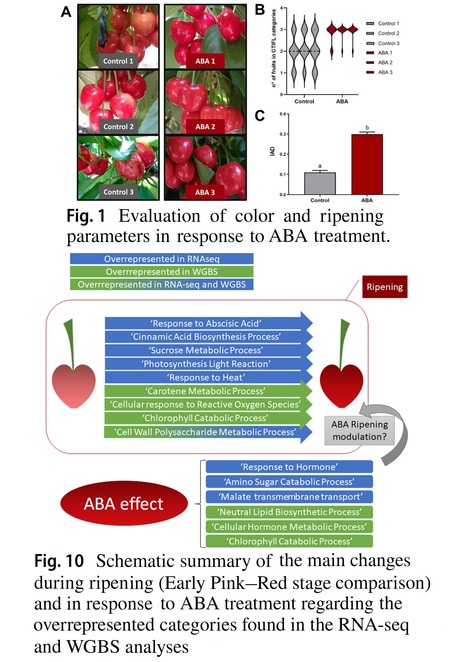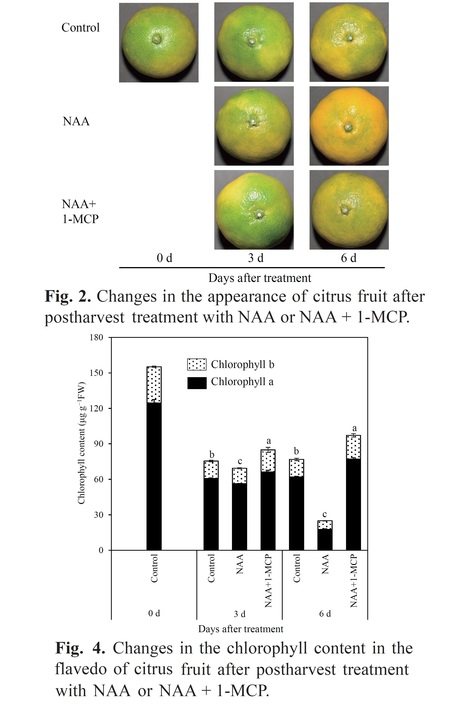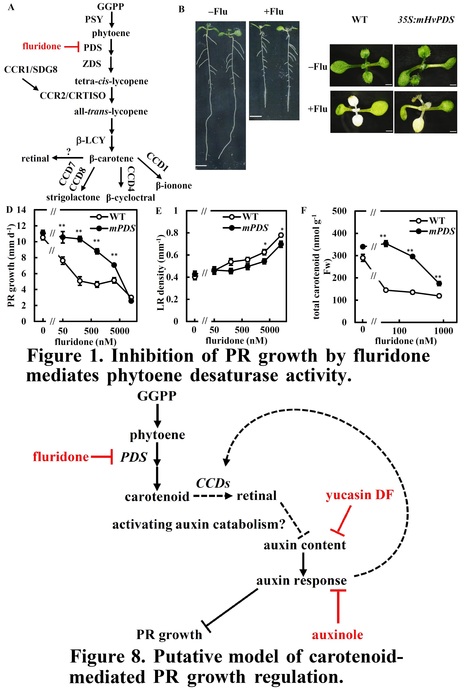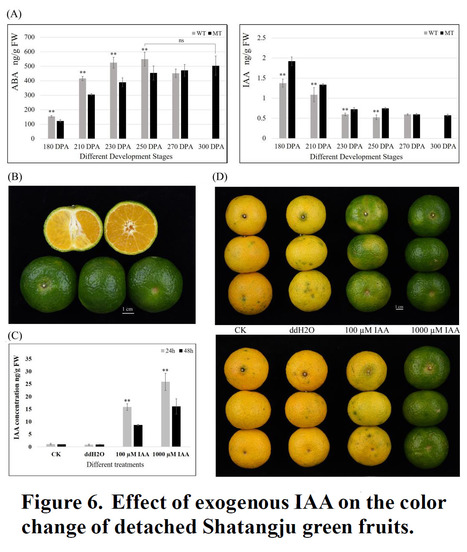 Your new post is loading...
 Your new post is loading...
Authors: Nathalie Kuhn, Macarena Arellano, Claudio Ponce, Christian Hodar, Francisco Correa, Salvatore Multari, Stefan Martens, Esther Carrera, José Manuel Donoso and Lee A. Meisel
Journal of Plant Growth Regulation (2024)
Abstract: "Abscisic acid (ABA) is a plant hormone that plays a key role in the ripening process of non-climacteric fruits, triggering pigment production, fruit softening, and sugar accumulation. Transcriptional studies show that ABA modifies the expression of several ripening-related genes, but epigenetic effects of ABA during this process are lacking. Therefore, this work aimed to perform transcriptomic and DNA methylation analyses of fruit samples treated with ABA during the fruit ripening process in the non-climacteric sweet cherry model. RNA-seq analyses revealed an overrepresentation of transcripts annotated in functional categories related to ABA response, secondary metabolism, and sugar synthesis during fruit ripening. In contrast, Whole Genome Bisulfite Sequencing (WGBS) analyses revealed DNA hypomethylation in the 5′UTR region of genes related to carotene catabolism. Transcriptional and epigenetic regulation of genes encoding xyloglucan enzymes, associated with cell wall modifications, were also detected. ABA treatment enhanced fruit color development and the accumulation of ripening markers, including carotenoids and several anthocyanins. Gene Ontology analysis in the RNA-seq of ABA-treated fruits revealed expression variations in genes encoding members of the Aux/IAA and ARF families. In the WGBS analysis, genes encoding enzymes for cytokinin biosynthesis had differential DNA methylation after the ABA treatment. Our work identified ABA-modulated factors at the genetic and epigenetic levels, suggesting complex hormone networks controlling non-climacteric sweet cherry fruit ripening."
Authors: Gang Ma, Lancui Zhang, Kan Murakami, Masaki Yahata and Masaya Kato.
The Horticulture Journal (2023)
Abstract: ‘Miyagawa-wase’ (Citrus unshiu Marcow.), an early-season citrus variety, is rich in multiple nutrients and widely consumed in Japan. In ‘Miyagawa-wase’, when the pulp reaches maturity and is ready to eat, the peel is still a greenish color because of the relatively high temperature in the harvest season. In this study, to improve the coloration of ‘Miyagawa-wase’ peel, we treated the fruit with 1-naphthaleneacetic acid (NAA) after harvest. The results showed that postharvest treatment with NAA was effective to induce chlorophyll degradation and carotenoid accumulation in ‘Miyagawa-wase’ peel during storage. In the NAA treatment, the reduction in the chlorophyll contents after harvest was in parallel with decreases in the expression of chlorophyll biosynthetic genes (CitGGDR, CitCHLH, CitCHL27, CitPORA, and CitCAO) and an increase in chlorophyll degradation gene CitPPH. The contents of the major carotenoids, β-cryptoxanthin and 9-cis-violaxanthin, were increased by the NAA treatment through upregulation of the expression of carotenoid biosynthetic genes (CitPSY, CitPDS, CitZDS, CitLCYb2, and CitHYb) after harvest. In addition, it was found that the positive effect on degreening in the NAA treatment was inhibited by the ethylene antagonist 1-MCP. In the combination treatment using NAA and 1-MCP, the total chlorophyll content was much higher, while the contents of β-cryptoxanthin and 9-cis-violaxanthin were lower compared with NAA treatment alone, indicating that the acceleration of degreening by NAA may be caused by ethylene. The results presented in this study suggest that postharvest NAA treatment is an effective method for improving the peel coloration in early-season citrus varieties."
Authors: Zhifei Li, Ying Pi, Changsheng Zhai, Dong Xu, Wenyao Ma, Hong Chen, Yi Li and Han Wu.
Plant Cell Reports (2022)
Key message: Tomato DWARF14 regulates the development of roots, shoot branches and leaves, and also plays a role in photosynthetic pigment accumulation and photosynthetic capacity.
Abstract: "Strigolactones (SLs) are a novel class of plant hormones. DWARF14 (D14) is the only SL receptor identified to date, but it is not functionally analyzed in tomato (Solanum lycopersicum). In the present study, we identified the potential SL receptor in tomato by bioinformatic analysis, which was designated as SlD14. SlD14 was expressed in roots, stems, flowers and developing fruits, with the highest expression level in leaves. sld14 mutant plants produced by the CRISPR/Cas9 system displayed reduced plant height and root biomass, increased shoot branching and altered leaf shape comparing with WT plants. The cytokinin biosynthetic gene ISOPENTENYLTRANSFERASE 3 (SlIPT3), auxin biosynthetic genes FLOOZY (SlFZY) and TRYPTOPHAN AMINOTRANSFERASE RELATED 1 (SlTAR1) and several auxin transport genes SlPINs, which are involved in branch formation, showed higher expression levels in the sld14 plant stem. In addition, sld14 plants exhibited light-green leaves, reduced chlorophyll and carotenoid contents, abnormal chloroplast structure and reduced photosynthetic capacity. Transcriptomic analysis showed that the transcript levels of six chlorophyll biosynthetic genes, three carotenoid biosynthetic genes and numerous chlorophyll a/b-binding protein genes were decreased in sld14 plants. These results suggest that tomato SL receptor gene SlD14 not only regulates the development of roots, shoot branches and leaves, but also plays a role in regulating photosynthetic pigment accumulation and photosynthetic capacity."
|
Authors: Kang Xu, Haoran Zeng, Emi Yumoto, Masashi Asahina, Ken-ichiro Hayashi, Hidehiro Fukaki, Hisashi Ito and Masaaki K. Watahiki.
bioRxiv (2023)
Abstract: "Carotenoids support plant developmental activities as photosynthesis and photoprotective pigments, and also provide precursors for production of phytohormone abscisic acid and strigolactones, or bioactive apocarotenoids. Herein, we examined the role of carotenoid as a source of apocarotenoids, which control endogenous auxin levels and plant root architecture. Inhibiting β-carotene biosynthesis by phytoene desaturase (PDS) inhibitor fluridone suppresses root growth, consequently inducing lateral root growth. PDS was confirmed to be the target of fluridone via the expression of the fluridone-insensitive trait 35S::mHvPDS in an Arabidopsis plant. Inhibiting β-carotene biosynthesis elevated endogenous auxin levels and activated auxin signaling, thereby suppressing root growth. In addition, the root growth of the auxin-deficient mutant yucQ was partially restored via fluridone treatment. These results indicate that suppressing PDS activity increases endogenous auxin levels and suppresses root growth. Conversely, the carotenoid pool indirectly suppresses endogenous auxin levels. Exogenous application of retinal, apocarotenoid derived from β-carotene, complemented fluridone-mediated root growth inhibition and partially recovered auxin-mediated growth inhibition. Moreover, retinal inhibited the induction of the auxin-inducible reporter pIAA19::ElucPEST, indicating an antagonistic effect of retinal on endogenous auxin levels. Interestingly, the auxin-deficient mutants wei2 wei7 and yucQ accumulated more β-carotene compared with the wild type. The expression of CCDs, which converts β-carotene into apocarotenoids, is auxin-inducible and increases following fluridone treatment. These results indicate feedback regulation during apocarotenoid biosynthesis in plant tissue. Thus, we conclude carotenoid regulates auxin levels and response, and this regulation is intermediated by apocarotenoid retinal."
Authors: Yuanda Lv, Shuang Ren, Bo Wu, Caizhong Jiang, Bo Jiang, Birong Zhou, Guangyan Zhong, Yun Zhong and Huaxue Yan.
Tree Physiology (2023)
Abstract: "Previous studies have shown that abscisic acid and ethylene are involved in pulp maturation and peel coloration in the nonclimacteric citrus fruits. There are also signs indicating that other plant hormones may play some roles in citrus fruit ripening. In this study, we compared profiles of genome-wide gene expression, and changes in hormones and peel pigments between fruits of Shatangju mandarin (Citrus reticulata Blanco, designated WT) and its natural mutant, Yuenongwanju (designated MT). The MT fruit mature approximately two months later than the WT fruit. Significant differences in fruit diameter, total soluble solids, titratable acid content, chlorophylls and carotenoids were detected between the fruits of the two genotypes at the sampled time points. Genome-wide transcriptome profiling showed that many genes involved in auxin and ABA metabolism and/or signaling pathways were differentially expressed between the MT and the WT fruits. Importantly, the expression of CrYUCCA8 was significantly lower and the expression of CrNCED5 was significantly higher in WT than in MT fruits at 230 and 250 DPA, respectively. In addition, the IAA level in the MT fruit was significantly higher than that in the WT counterpart, whereas a significantly lower level of ABA was detected in the mutant. Treatment of the WT fruit with exogenous IAA significantly delayed fruit maturation. Our results provide experimental evidence supporting the notion that auxin is a negative regulator of fruit maturation in citrus."
|



 Your new post is loading...
Your new post is loading...











